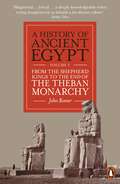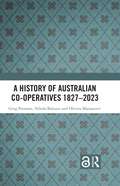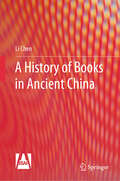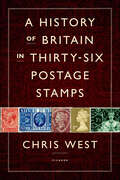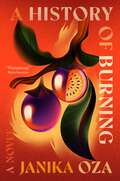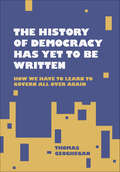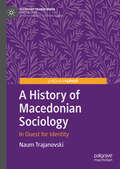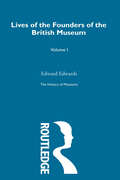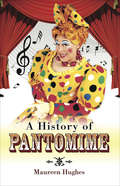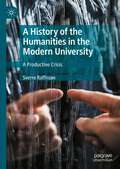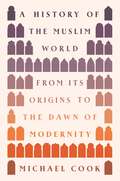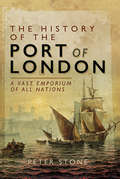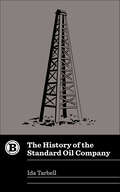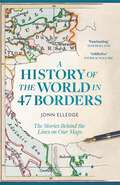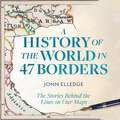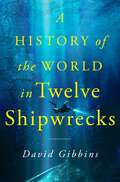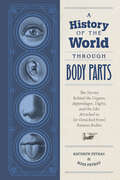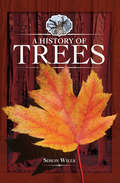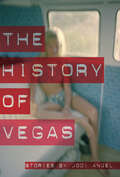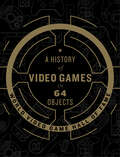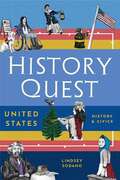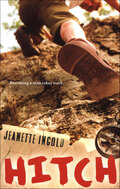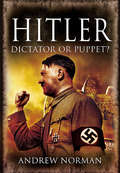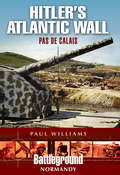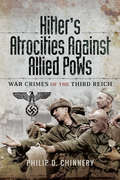- Table View
- List View
A History of Ancient Egypt, Volume 3: From the Shepherd Kings to the End of the Theban Monarchy
by John RomerThe final chapter in the definitive, three-volume history of the world's first known stateArchaeologist John Romer has spent a lifetime chronicling the history of Ancient Egypt, and here he tells the epic story of an era dominated by titans of the popular imagination: the radical iconoclast Akhenaten, the boy-king Tutankhamun and the all-conquering Ramesses II. But 'heroes' do not forge history by themselves. This was also a time of international trade, cultural exchange and sophisticated art, even in the face of violent change.Alongside his visionary new history of this, the most famous period in the long history of Ancient Egypt, Romer turns a critical eye on Egyptology itself. Paying close attention to the evidence, he corrects prevailing narratives which cast the New Kingdom as an imperial state power in the European mould. Instead, he reveals - through broken artefacts in ruined workshops, or preserved letters between a tomb-builder and his son - a culture more beautiful and beguiling than we could have imagined.Romer carefully reconstructs the real story of the New Kingdom as evidenced in the archaeological record, and the result - the final volume of a life long project - secures his status as Ancient Egypt's finest chronicler.
A History of Australian Co-operatives 1827–2023
by Greg Patmore Nikola Balnave Olivera MarjanovicCo-operatives provide a different approach to organising business through their ideals of member ownership and democratic practice. Every co-operative member has an equal vote regardless of his or her own personal capital investment. They take a variety of different forms, including consumer co-operatives, agricultural co-operatives, worker co-operatives and financial co-operatives.Patmore, Balnave and Marjanovic provide a perspective on Australian co-operative development within a conceptual framework and international context since the 1820s by exploring the economic, political and social factors that explain their varying fortunes. Drawing upon the Visual Historical Atlas of Australian Co-operatives, a significant database of Australian co-operatives and a variety of historical sources, this book provides a detailed historical analysis of their development, from their inception in Australia to today. Australian co-operatives were heavily dependent on state sympathy for their growth and vulnerable to ideas that challenged collective organisation such as Neo-liberalism. Despite these challenges, the co-operative business model has persisted and since 2009, there has been resurgence of interest and organisation that may provide a platform for future growth.A useful resource for practitioners, students, educators, policy makers and researchers that highlights a significant alternative business model to the Investor-Owned Business and state enterprise.The Open Access version of this book, available at http://www.taylorfrancis.com, has been made available under a Creative Commons [Attribution-Non Commercial-No Derivatives (CC-BY-NC-ND)] 4.0 license.
A History of Books in Ancient China
by Li ChenThis book presents a study of the history of ancient Chinese books, not only highlighting specific aspects of the ontology of book history, such as printing and publishing, but also analyzing the internal and external causes of the development of book undertakings from a macro-perspective. Placing the development of and changes in the history of books in the context of social development, it investigates its interaction with politics, economy, society, education, and religion, especially with the big culture, and constructs a book-centered history of ancient Chinese culture.
A History of Britain in Thirty-Six Postage Stamps
by Chris WestStamps tell a story-and Chris West's book is the unique, fascinating tale of Great Britain told through its stamps.Hailed by The Times of London as "a splendid reminder of the philatelic glories of the past," A History of Britain in 36 Postage Stamps tells the rich, layered, and breathtaking history of England through thirty-six of its fascinating, often beautiful, and sometimes eccentric postage stamps. West shows that stamps have always mirrored the events, attitudes, and styles of their time. Through them, one can glimpse the whole epic tale of an empire unfolding. From the famous Penny Black, printed soon after Queen Victoria's coronation, to the Victory! stamp of 1946, anticipating the struggle of postwar reconstruction-A History of Britain in 36 Postage Stamps is a hugely entertaining and idiosyncratic romp, told in Chris West's lively prose.On their own, stamps can be curiosities, even artistic marvels; in this book, stamps become a window into the larger sweep of history.
A History of Burning
by Janika OzaThis epic, sweeping historical novel full of "wondrous complexity&” spans continents and a century, and reveals how one act of survival can reverberate through generations (Rachel Khong, author of Goodbye, Vitamin). &“Remarkable….a haunting, symphonic tale&” —New York Times Book Review In 1898, Pirbhai, a teenage boy looking for work, is taken from his village in India to labor for the British on the East African Railway. Far from home, Pirbhai commits a brutal act in the name of survival that will haunt him and his family for years to come. So begins Janika Oza&’s masterful, richly told epic, where the embers of this desperate act are fanned into flame over four generations, four continents, throughout the twentieth century. Pirbhai&’s children are born in Uganda during the waning days of British colonial rule, and as the country moves toward independence, his granddaughters, three sisters, come of age in a divided nation. Latika is an aspiring journalist, who will put everything on the line for what she believes in; Mayuri&’s ambitions will take her farther away from home than she ever imagined; and fearless Kiya will have to carry the weight of her family&’s silence and secrets. In 1972, the entire family is forced to flee under Idi Amin&’s military dictatorship. Pirbhai&’s grandchildren are now scattered across the world, struggling to find their way back to each other. One day a letter arrives with news that makes each generation question how far they are willing to go, and who they are willing to defy, to secure their own place in the world.A History of Burning is an unforgettable tour de force, an intimate family saga of complicity and resistance, about the stories we share, the ones that remain unspoken, and the eternal search for home.Includes a Reading Group Guide.
The History of Democracy Has Yet to Be Written: How We Have to Learn to Govern All Over Again
by Thomas Geoghegan"This book made me laugh out loud and also gave me glimpses of an entire horizon of possibility I hadn't seen before."--Chris Hayes, host of MSNBC's All In with Chris Hayes End the filibuster. Abolish
A History of Macedonian Sociology: In Quest for Identity (Sociology Transformed)
by Naum TrajanovskiThis book is the first English-language monograph about the institutional development of sociology in (North) Macedonia. It maps and discusses the contexts, goals, and merits of the pioneering attempts for sociological research in the interwar period, early post-war educational and publishing politics, the institutionalization of sociology in socialist Macedonia in the course of the 1960s, its cross-national exchanges, as well as its major trajectories and debates up until the present days. Against the backgrounds of the political and intellectual histories of Yugoslav and post-Yugoslav Macedonia, it argues that the development of the sociological activities, themes, and arguments is entwined with the Macedonian nation- and state-building.
The History of Museums Vol 1: With Notices Of Its Chief Augmentors And Other Benefactors, 1570-1870
by Edward EdwardsMuseums and collecting is now a major area of cultural studies. This selected group of key texts opens the investigation and appreciation of museum history. Edward Edwards, chief pioneer of municipal public libraries, chronicles the founders and early donors to the British Museum. Greenwood and Murray provide informative pictures of the early history of the museum movement. Sir William Flower, Director of the British Museum (Natural History), takes a pioneering philosophical approach to the sphere of natural history in relation to museums. Similarly, Acland and Ruskin discuss and explore the relationships of art and architecture to museums.
A History of Pantomime
by Maureen HughesEach Christmas entire families in the UK troop off to see, what one could almost say is 'the obligatory'. annual entertainment, known as Pantomime. It is a traditional, seasonal way of life for the British envied the world over, and one which only the British seem to understand! Pantomime serves both to entertain and to introduce each new generation to the joys of theatre in the most unique of ways, for this is not a type of theatre one merely watches, but one in which the audience participate often in the most seemingly boisterous and bizarre of ways. The whole experience is steeped in tradition, traditions which only the British seem to understand, which is probably why we are proud to call it a 'British Experience.'In A History of Pantomime Maureen Hughes takes a brief look at the history of Pantomime as well as taking a humorous look at some of the above mentioned traditions; she also gives a synopsis of each of the well-known Pantomimes whilst exploring the eccentric world of the characters who appear in them. There is also a short piece on just some of the most well-known and loved of the actors who each Christmas take on the part of Pantomime Dames across the UK, as well as a look at others who have contributed to this magical world of fun and eccentricity. It is thought by some to be frivolous and pointless piece of theatre, but a browse through this informative book and you will soon find that Pantomime is an art form all of its own, requiring the most dedicated and talented of actors/actresses who are prepared to honour and perpetuate this wonderful tradition as it is passed down from one generation to the next.As seen in The Telegraph and the Sunday Post (Glasgow).
A History of the Humanities in the Modern University: A Productive Crisis
by Sverre RaffnsøeThis book challenges commonplace assertions that the humanities are presently undergoing a severe crisis as a result of a longstanding decline. Rather than hearkening to the widespread, reactive call for a last-ditch defense of the humanities under attack from an ungracious world, this book fundamentally reverses the perspective and makes a plea for a different, affirmative approach. It contends that the humanities have incessantly arrived at critical turning points since they were first constituted in a form that remains recognizable today and assumed a leading role in knowledge organization with the establishment of the modern university around 1800. Assuming a historical perspective, the monograph takes the human sciences back to their rightful place in the family tree of sciences and gives due recognition to their continuously decisive role in the production of new knowledge and the creation of new fields of knowledge. Situating the ongoing gemmation of the humanities in a broader context, this monograph also offers an encompassing introduction to the over-all development of knowledge in the last two hundred years.
A History of the Muslim World: From Its Origins to the Dawn of Modernity
by Michael A. CookA panoramic history of the Muslim world from the age of the Prophet Muḥammad to the birth of the modern eraThis book describes and explains the major events, personalities, conflicts, and convergences that have shaped the history of the Muslim world. The body of the book takes readers from the origins of Islam to the eve of the nineteenth century, and an epilogue continues the story to the present day. Michael Cook thus provides a broad history of a civilization remarkable for both its unity and diversity.After setting the scene in the Middle East of late antiquity, the book depicts the rise of Islam as one of the great black swan events of history. It continues with the spectacular rise of the Caliphate, an empire that by the time it broke up had nurtured the formation of a new civilization. It then goes on to cover the diverse histories of all the major regions of the Muslim world, providing a wide-ranging account of the key military, political, and cultural developments that accompanied the eastward and westward spread of Islam from the Middle East to the shores of the Atlantic and the Pacific.At the same time, A History of the Muslim World contains numerous primary-source quotations that expose the reader to a variety of acutely insightful voices from the Muslim past.
The History of the Port of London: A Vast Emporium of All Nations
by Peter Stone&“This meticulously researched account underlines the importance of the capital&’s docklands . . . from Roman landing to modern financial centre.&” —Discover Britain The River Thames has been integral to the prosperity of London since Roman times. Explorers sailed away on voyages of discovery to distant lands. Colonies were established and a great empire grew. Funding their ships and cargoes helped make the City of London into the world&’s leading financial center. In the nineteenth century a vast network of docks was created for ever-larger ships, behind high, prison-like walls that kept them secret from all those who did not toil within. Sail made way for steam as goods were dispatched to every corner of the world. In the nineteenth century London was the world&’s greatest port city. In the Second World War the Port of London became Hitler&’s prime target. It paid a heavy price but soon recovered. Yet by the end of the 20th century the docks had been transformed into Docklands, a new financial center. The History of the Port of London: A Vast Emporium of Nations is the fascinating story of the rise and fall and revival of the commercial river. The only book to tell the whole story and bring it right up to date, it charts the foundation, growth and evolution of the port and explains why for centuries it has been so important to Britain&’s prosperity. This book will appeal to those interested in London&’s history, maritime and industrial heritage, the Docklands and East End of London, and the River Thames.
The History of the Standard Oil Company (Belt Revivals)
by Ida TarbellPart of Belt's Revivals Series, a classic of muckraking journalism with a new introduction by Elizabeth Catte, author of What You Are Getting Wrong About Appalachia and Pure America . Cleveland oil tycoon Jo
A History of the World in 47 Borders: The Stories Behind the Lines on Our Maps
by Jonn Elledge'Fascinating and hugely entertaining' MARINA HYDE'By turns surprising, funny, bleak, ridiculous, or all four of those at once' GIDEON DEFOEPeople have been drawing lines on maps for as long as there have been maps to draw on. Sometimes rooted in physical geography, sometimes entirely arbitrary, these lines might often have looked very different if a war or treaty or the decisions of a handful of tired Europeans had gone a different way. By telling the stories of these borders, we can learn a lot about how political identities are shaped, why the world looks the way it does - and about the scale of human folly.From the Roman attempts to define the boundaries of civilisation, to the secret British-French agreement to carve up the Ottoman Empire during the First World War, to the reason why landlocked Bolivia still maintains a navy, this is a fascinating, witty and surprising look at the history of the world told through its borders.
A History of the World in 47 Borders: The Stories Behind the Lines on Our Maps
by Jonn Elledge'Fascinating and hugely entertaining' MARINA HYDE'By turns surprising, funny, bleak, ridiculous, or all four of those at once' GIDEON DEFOEPeople have been drawing lines on maps for as long as there have been maps to draw on. Sometimes rooted in physical geography, sometimes entirely arbitrary, these lines might often have looked very different if a war or treaty or the decisions of a handful of tired Europeans had gone a different way. By telling the stories of these borders, we can learn a lot about how political identities are shaped, why the world looks the way it does - and about the scale of human folly.From the Roman attempts to define the boundaries of civilisation, to the secret British-French agreement to carve up the Ottoman Empire during the First World War, to the reason why landlocked Bolivia still maintains a navy, this is a fascinating, witty and surprising look at the history of the world told through its borders.
A History of the World in Twelve Shipwrecks
by David GibbinsFrom renowned underwater archaeologist David Gibbins comes an exciting and rich narrative of human history told through the archaeological discoveries of twelve shipwrecks across time.The Viking warship of King Cnut the Great. Henry VIII's the Mary Rose. Captain John Franklin's doomed HMS Terror. The SS Gairsoppa, destroyed by a Nazi U-boat in the Atlantic during World War II.Since we first set sail on the open sea, ships and their wrecks have been an inevitable part of human history. Archaeologists have made spectacular discoveries excavating these sunken ships, their protective underwater cocoon keeping evidence of past civilizations preserved. Now, for the first time, world renowned maritime archeologist David Gibbins ties together the stories of some of the most significant shipwrecks in time to form a single overarching narrative of world history.A History of the World in Twelve Shipwrecks is not just the story of those ships, the people who sailed on them, and the cargo and treasure they carried, but also the story of the spread of people, religion, and ideas around the world; it is a story of colonialism, migration, and the indominable human spirit that continues today. From the glittering Bronze Age, to the world of Caesar's Rome, through the era of the Vikings, to the exploration of the Arctic, Gibbins uses shipwrecks to tell all.Drawing on decades of experience excavating shipwrecks around the world, Gibbins reveals the riches beneath the waves and shows us how the treasures found there can be a porthole to the past that tell a new story about the world and its underwater secrets.
A History of the World Through Body Parts: The Stories Behind the Organs, Appendages, Digits, and the Like Attached to (or Detached from) Famous Bodies
by Kathy Petras Ross PetrasA grab bag of historic spleens, chins, and more, this is your ultimate literary dissection of body parts throughout history!From famous craniums to prominent breasts, ancient spleens and bound feet, this book will bring history to life in a whole new way. With their inimitable wit and probing intelligence, authors Kathy and Ross Petras look at the role the human body has played throughout history as each individual part becomes a jumping-off point for a wider look at the times. In far-ranging, quirky-yet-interrelated stories, learn about Charles II of Spain's jaw and the repercussions of inbreeding, what Anne Boleyn's heart says about the Crusades and the trend of dispersed burials, and what can be learned about the Aztecs through Moctezuma's pierced lip. A History of the World Through Body Parts is packed with fascinating little-known historical facts and anecdotes that will entertain, enlighten, and delight even the most well-read history buff.BESTSELLING AUTHORS: Kathy and Ross Petras have authored the New York Times bestseller You're Saying It Wrong and the hit calendar The 365 Stupidest Things Ever Said, now in its 24th year with over 4.8 million copies sold!ENGAGING CONTENT: Packed with rich material told with a lively and humorous voice, take a trip through history in this unique, exciting way.QUIRKY HISTORY FANS REJOICE!: For fans of The Disappearing Spoon, Wicked Plants, The Violinist's Thumb, The Sawbones Book and Strange Histories!Perfect for:• History buffs and pop history fans• Father's Day, birthday, and holiday shoppers
A History of Trees
by Simon WillsMake Arbor Day every day with little known and intriguing facts about the plants that populate our forests, give us shade, and clean our air. Have you ever wondered how trees got their names? What did our ancestors think about trees, and how were they used in the past? This fascinating book will answer many of your questions, but also reveal interesting stories that are not widely known. For example, the nut from which tree was predicted to pay off the UK&’s national debt? Or why is Europe&’s most popular pear called the &“conference&”? Simon Wills tells the history of twenty-eight common trees in an engaging and entertaining way, and every chapter is illustrated with his photographs. Find out why the London plane tree is so frequently planted in our cities, and how our forebears were in awe of the magical properties of hawthorn. Where is Britain&’s largest conker tree? Which tree was believed to protect you against both lightning and witchcraft? The use of bay tree leaves as a sign of victory by athletes in ancient Greece led to them being subsequently adopted by many others—from Roman emperors to the Royal Marines. But why were willow trees associated with Alexander Pope, Napoleon Bonaparte, and Samuel Johnson? Why did Queen Anne pay a large sum for a cutting from a walnut tree in Somerset? Discover the answers to these and many other intriguing tales within the pages of this highly engrossing book.
The History of Vegas: Stories
by Jodi AngelTrouble. From the first page of each of the edgy and unrelentingly intense stories in this debut collection, the teenaged characters are headed for big trouble. The adult world has mostly failed them, and they find themselves entering into highly charged situations where they make their own rules, with misguided understanding of the consequences. The stories burn hot and fast, providing searing insights into their world of sex, drugs, drinking, violence, and accidental grace, played out in small, tough towns. Written with raw directness and understanding that makes these nine stories impossible to forget, The History of Vegas announces an exciting, fresh talent with the impact of Mary Gaitskill, Mary Karr, and Jayne Anne Phillips.
A History of Video Games in 64 Objects
by World Video Game Hall of FameInspired by the groundbreaking A History of the World in 100 Objects, this book draws on the unique collections of The Strong museum in Rochester, New York, to chronicle the evolution of video games, from Pong to first-person shooters, told through the stories of dozens of objects essential to the field’s creation and development.Drawing on the World Video Game Hall of Fame’s unmatched collection of video game artifacts, this fascinating history offers an expansive look at the development of one of the most popular and influential activities of the modern world: video gaming.Sixty-four unique objects tell the story of the video game from inception to today. Pithy, in-depth essays and photographs examine each object’s significance to video game play—what it has contributed to the history of gaming—as well as the greater culture.A History of Video Games in 64 Objects explains how the video game has transformed over time. Inside, you’ll find a wide range of intriguing topics, including:The first edition of Dungeons & Dragons—the ancestor of computer role-playing gamesThe Oregon Trail and the development of educational gamingThe Atari 2600 and the beginning of the console revolutionA World of Warcraft server blade and massively multiplayer online gamesMinecraft—the backlash against the studio systemThe rise of women in gaming represented by pioneering American video game designers Carol Shaw and Roberta Williams’ game development materialsThe prototype Skylanders Portal of Power that spawned the Toys-to-Life video game phenomenon and shook up the marketplaceAnd so much more!A visual panorama of unforgettable anecdotes and factoids, A History of Video Games in 64 Objects is a treasure trove for gamers and pop culture fans. Let the gaming begin!
History Quest: United States
by Lindsey SodanoHistory United States is a secular homeschool curriculum covering the history and civics of the United States from the 1500s to the early 21st century. Because it is secular, the text presents religious beliefs from this period not as factual accounts, but as relevant sources and perspectives to be considered through a historical lens. Designed as a read-aloud for upper elementary-age children, an independent read for older students, or a journey of thrilling stories to be shared during family story time, this main text of the History United States curriculum presents an immersive study of U.S. history and civics in an engaging and memorable format. Used alongside the History United States Study Guide and other recommended resources, your students will learn about the ideas, conflicts, inventions, and individuals that shaped the United States (and the world) and take their first step in a life-long quest to explore and appreciate history.
Hitch
by Jeanette IngoldAs a teenager growing up during the Depression, Moss Trawnley doesn't have time to be a kid. In search of opportunity, Moss lies about his age and heads west to join Roosevelt's Civilian Conservation Corps. While working to protect Montana's wildlife, he goes to school, makes lifelong friends, falls in love, and finds what he almost lost in the crisis of the Great Depression: himself.In this captivating work of fiction, Jeanette Ingold tells the story of a teen who risks everything to start a new life and, in the process, gains a future.
Hitler: Dictator or Puppet?
by Andrew NormanWritten by an authority on Adolf Hitler, this book charts new ground and shows how the writings of a deluded ex-monk, Lanz von Liebenfels and the pseudo-science of Liebenfels and other writers, convinced Hitler that Germanys destiny was to save the world from a Jewish-Bolshevik conspiracy. It was this perverted sense of destiny that drove the Nazi Party and led to the outbreak of WWII and the deaths of some sixty million people as well as the destruction of much of Europe. Using the writings of Liebenfels from his magazine Ostara, Dr Andrew Norman demonstrates how the mass murders of Jews, Gypsies, mentally-ill people and those regarded as less than human had its roots in articles written by Liebenfels. An index of Ostara articles is included and their very titles indicate the malign influences that shaped Hitlers Germany.
Hitler's Atlantic Wall: Pas de Calais (Battleground Normandy)
by Paul WilliamsThis well-illustrated book describes the massive effort that the occupying Nazi forces put into the construction of the Eastern section of the Atlantic Wall. While the D-Day invasion was unaffected by the fortifications in this area, they still posed a significant threat. This came from the mighty gun batteries (such as Batteries Todt and Lindemann) that threatened Channel shipping and the South Coast of England, and, while isolated from the main Allied advance, the Festung ports of Calais, Boulogne and Dunkirk were denied to Allied use. This was of major strategic significance as the lines of supply were becoming ever longer and more vulnerable.Using rare archive material, this book takes the reader on a fascinating journey along the coast that Hitler was wrongly convinced would be the site of the Allied landings. Hitlers Atlantic Wall Pas de Calais tells the history of how and why the giant batteries were built, the origins of their weaponry and the ingenious engineering and military operations that defeated them finally.
Hitler's Atrocities Against Allied PoWs: War Crimes of the Third Reich
by Philip D. Chinnery“A chilling description of the ordeals that captured men and women were put through by the Third Reich regime and their Italian allies.” —Daily MailSeventy years ago, the Nuremberg Trials were in full swing in Germany. In the dock were the leaders of the Nazi regime and most eventually received their just desserts. But what happened to the other war criminals?In June 1946, Lord Russell of Liverpool became Deputy Judge Advocate and legal adviser to the Commander in Chief for the British Army of the Rhine in respect of all trials held by British Military Courts of German war criminals. He later wrote:“At the outbreak of the Second World War, the treatment of prisoners was governed by the Geneva Prisoner of War Convention of 1929, the Preamble of which stated that the aim of the signatories was to alleviate the conditions of prisoners of war.“During the war, however, the provisions of the Convention were repeatedly disregarded by Germany. Prisoners were subjected to brutality and ill-treatment, employed on prohibited and dangerous work, handed over to the SD for ‘special treatment’ in pursuance of Hitler’s Commando Order, lynched in the streets by German civilians, sent to concentration camps, shot on recapture after escaping, and even massacred after they had laid down their arms and surrendered.”Tens of thousands of Allied prisoners of war died at the hands of the Nazis and their Italian allies. This book is for them lest we forget.“A sobering and harrowing book, detailing many forgotten crimes committed against POWs who should have been offered the protection of the Geneva Convention, but tragically were not.” —Recollections of WWII
